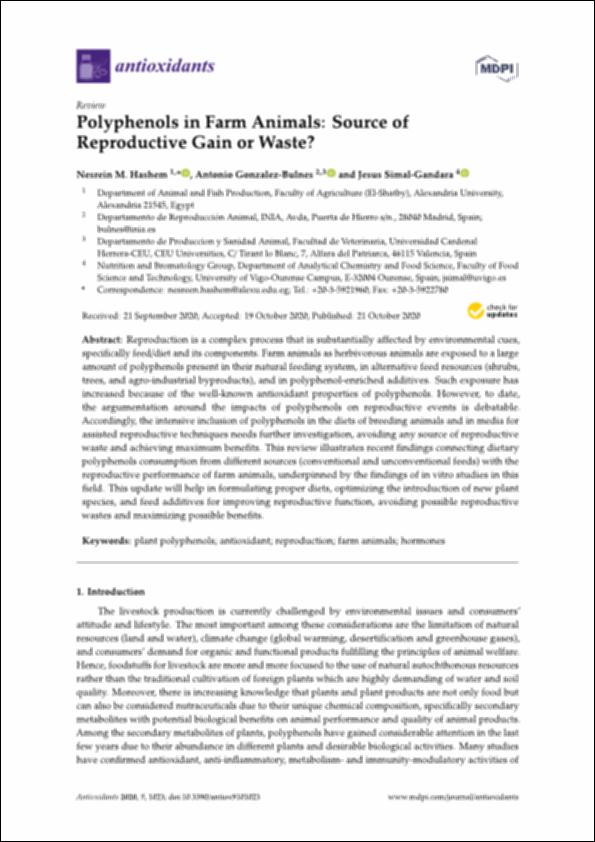Por favor, use este identificador para citar o enlazar este ítem:
http://hdl.handle.net/10637/12539Polyphenols in farm animals : source of reproductive gain or waste?
| Título : | Polyphenols in farm animals : source of reproductive gain or waste? |
| Autor : | Hashem, Nesrein M. González de Bulnes López, Antonio Simal Gándara, Jesús |
| Materias: | Antioxidants.; Granjas.; Farms.; Reproducción animal.; Nutrición animal.; Hormonas vegetales.; Plant hormones.; Animal nutrition.; Antioxidantes.; Reproduction. |
| Editorial : | MDPI |
| Citación : | Hashem, N.M., Gonzalez-Bulnes, A. & Simal-Gandara, J. (2020). Polyphenols in farm animals: source of reproductive gain or waste?. Antioxidants, vol. 9, i. 10 (21 oct.), art. 1023. DOI: https://doi.org/10.3390/antiox9101023 |
| Resumen : | Reproduction is a complex process that is substantially a ected by environmental cues, specifically feed/diet and its components. Farm animals as herbivorous animals are exposed to a large amount of polyphenols present in their natural feeding system, in alternative feed resources (shrubs, trees, and agro-industrial byproducts), and in polyphenol-enriched additives. Such exposure has increased because of the well-known antioxidant properties of polyphenols. However, to date, the argumentation around the impacts of polyphenols on reproductive events is debatable. Accordingly, the intensive inclusion of polyphenols in the diets of breeding animals and in media for assisted reproductive techniques needs further investigation, avoiding any source of reproductive waste and achieving maximum benefits. This review illustrates recent findings connecting dietary polyphenols consumption from di erent sources (conventional and unconventional feeds) with the reproductive performance of farm animals, underpinned by the findings of in vitro studies in this field. This update will help in formulating proper diets, optimizing the introduction of new plant species, and feed additives for improving reproductive function, avoiding possible reproductive wastes and maximizing possible benefits. |
| Descripción : | Este artículo se encuentra disponible en la siguiente URL: https://www.mdpi.com/2076-3921/9/10/1023 Este artículo pertenece al número especial "Antioxidants in Veterinary medicine". |
| URI : | http://hdl.handle.net/10637/12539 |
| Derechos: | http://creativecommons.org/licenses/by/4.0/deed.es |
| ISSN : | 2076-3921 (Electrónico). |
| Fecha de publicación : | 21-oct-2020 |
| Centro : | Universidad Cardenal Herrera-CEU |
| Aparece en las colecciones: | Dpto. Producción y Sanidad Animal, Salud Pública Veterinaria y Ciencia y Tecnología de los Alimentos |
Los ítems de DSpace están protegidos por copyright, con todos los derechos reservados, a menos que se indique lo contrario.


